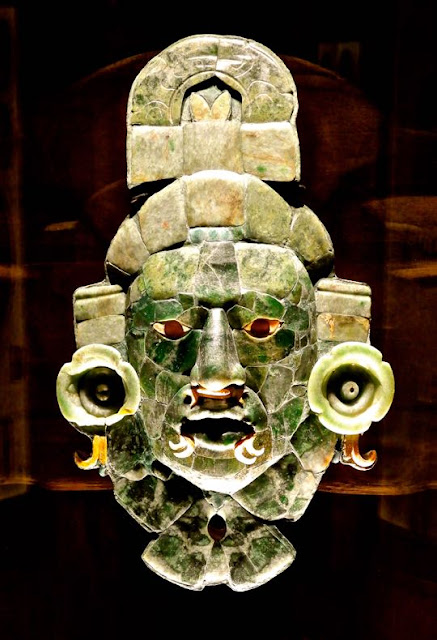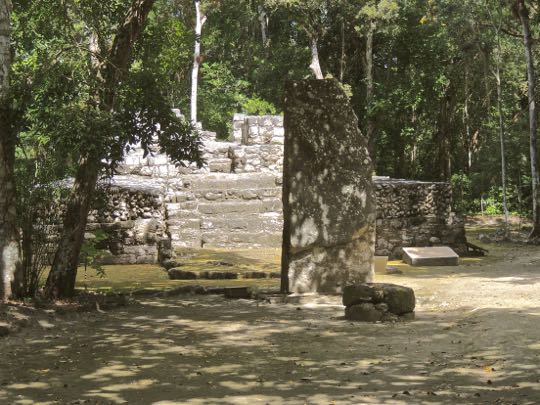This posting focuses on Structure 1, of Acropolis Ch'iik Naahb. Most of my information is drawn from two archeological reports. One focuses on the images and the other on the hieroglyphic captions that accompany them. Except for one, all photos and diagrams in this posting come from those two reports. The one exception is the photo of the exterior of Structure 1 as it appears today. The murals are inside the pyramid and were not open to the public when we visited.
Overview
Site map of Calakmul showing Acropolis Ch'iik Naahb. The Acropolis is located directly to the north of the Gran Plaza, which I covered earlier in this series. Ch'iik Naahb ("Place of the Water Lily") is one of the ancient names used to describe Calakmul. Archeologists decided to give this label to the acropolis containing Structure 1.The name Calakmul ("Two Adjacent Mounds") was created by Cyrus Lundell to describe the ruins he found in 1931. On the map above, an arrow points to the location of Structure 1. (Map from Daily Life of the Ancient Maya recorded on murals at Calakmul, by Ramon Carrasco Vargas, et al.)
Another detail from the mural containing the Woman in Blue . The man shown is seated behind the woman with the pot on her head. He is drinking atole, a hot drink based on corn hominy flour. It is still popular all over Mexico. The modern version is flavored with cane sugar, cinnamon vanilla and sometimes includes chocolate or fruit. Atole has the consistency of thick Cream of Wheat cereal.
The drinker wears ear rings and has a scarf on his head. Like all the men depicted in the murals, he is bare-chested. The caption in the upper left translates as "Atole Person". However, this doesn't refer to the drinker but to the women with the pot. Usually, captions accompanying Maya murals provide individual names. However, these only describe roles. Like the focus on common people, this is very unusual in Maya murals.
Layout of Acropolis Ch'iik Naahb. The Acropolis is roughly square and measures about 150m (492ft) per side. In total, it covers approximately 2.5 hectares (6.2 acres). Within its boundaries are 68 structures grouped in 11 clusters, alphabetically labeled as Groups A through I. Cluster I contains the tallest building in the Acropolis, the three-level pyramid called Structure 1. So far, the only detailed information I have been able to find on Acropolis Ch'iik Naahb focuses solely on Structure 1 and its murals.
Structure 1, as it stands today. This the only photo taken by me in this posting. The pyramid has three-levels, with a broad area on the third level that once contained a temple made from perishable materials. The main staircase (on left) has a disk-shaped altar at its base. What you see above is the reconstruction of the latest version of the structure. It covers the earlier versions, and each of those covers the one previous to it.
 |
There are two sets of murals within the acropolis. The first is in Group A, which forms the southern boundary of Ch'iik Naahb. I did not see or photograph these, but the reports describe aquatic scenes painted along the boundary wall. The second set was found when archeologists tunneled inside Structure 1. The pyramid has a total of six substructures. The murals decorate the corners of the pyramid and sides of the stairs on the fourth substructure, called Sub 1-4.
Structure 1
Of the six substructures, the earliest (Sub 1-6) was built approximately 420 AD in the Early Classic period. The five succeeding substructures were all built during the Late Classic (600-900 AD). Ceramic fragments buried in the construction fill allowed a fairly accurate chronology. Structure 1, along with the rest of Group I, seems to have functioned as the religious and administrative center of Acropolis Ch'iik Naahb. The Acropolis may have functioned as a large market or possibly as a site to distribute tribute.
The murals of Sub 1-4 were covered over by the subsequent enlargements of the pyramid. Usually, this would have resulted in their destruction. However, the ancient architects seem to have considered the images to be especially important because they took great care to protect them with a layer of mud. They would not be seen again for nearly fourteen hundred years.
A closer look at the murals
Mural SE-S1 at the lower left of the southeast corner. This is the best-known of all the murals. You may recognize the Woman in Blue and the male drinker from the first two photos. The caption just above the man says "Atole Person", referring to the two women. The four hieroglyphs just behind the Woman in Blue reads "taking off the load". This apparently refers to her removal of the heavy pot from the head of the kneeling woman.
In the murals, the men are bare-chested and wear sarong-type garments around their waists. Usually they wear patterned scarves around their heads. The women are dressed in garments that cover their breasts and extend to mid-calf. Most of the women wear their hair in a kind of ponytail and use red makeup to partially cover their faces. The face of the kneeling woman is entirely red and this may be an attempt to illustrate her exertion.
In front of him is a platter containing a large round object with an opening in its top. The object in his hand is the same color as the opening, suggesting that it may have come from there. The glyphs are difficult to translate but may read as either calabaza (pumpkin) or nixtamal (maiz dough). My bet is calabaza, since the reddish color of the object is similar to the interior of a pumpkin.
Mural SE-E2 is captioned "Tobacco Person". When I first saw this mural, I thought it showed two scribes or artists working on a project. However the archeological analysis (as well as the caption) suggests a very different scene. Tobacco was sometimes used medicinally. When mixed with secretions of the bufo marinus toad, it could also produce hallucinogenic effects.
The shaman on the right has used a spatula to dip the tobacco- hallucinogen out of the pot he holds in his left hand. He offers it to the man on the left, who is bending over while supporting himself with his hands. He appears to be spitting, or possibly vomiting, since his mouth is open and something is dripping from it. This would suggest the beginning of an hallucinogenic experience.
Detail of Mural SE-E1 shows another scene with atole. There are two figures, but the full mural also contains a woman, out of sight on the right. The person on the left is bare-chested like a man but wears the face paint of a woman and a woman's hat. S/he holds a dipper in the left hand. Liquid pours from the dipper into a wide platter, which is balanced on a large basket. Cradled under the figure's right arm is a large pot, presumably the source of the liquid.
The man on the right drinks deeply from a blue pot, probably containing the same fluid. He is stylishly attired, with a ring in his left ear and a fancy sarong around his lower body. The caption between the two figures says "Atole Person". An inscription on the rim of the blue pot reads "his atole" indicating that the container belongs to the man on the right.
The large pot on the porter's back is supported by a woven base. It's not clear what is in the pot. However, many of the murals involve food made from maiz, so the pot may contain dried kernels of the grain or possibly even freshly-made atole. Some sort of creature--possibly a possum--sits on the rim of the pot. Whether the creature is pet or a mythical image is unknown.
So, what are the Ch'iik Naahb murals all about? Several aspects make them unique. 1) Many of the key figures are female, an unusual feature in a Maya mural. 2) The captions describe roles rather than individual names, i.e. Atole Person, Tobacco Person, etc. 3) The interactions seem to be transactional, as in a market, rather than social gatherings of family or friends.
All of this implies a market, with women as the primary sellers and men the buyers. However, archeologists are still mulling this over. The exact social mechanisms by which goods and services were exchanged in the ancient Maya world are still unclear. It has also been suggested that these scenes illustrate the distribution of tribute collected from Calakmul's many client states.
This completes Part 6 of my Calakmul series and concludes the series itself. I hope you have enjoyed this posting as well as the other five. If so, please leave any thoughts or questions in the Comments section below or email me directly.
Hasta luego, Jim
































